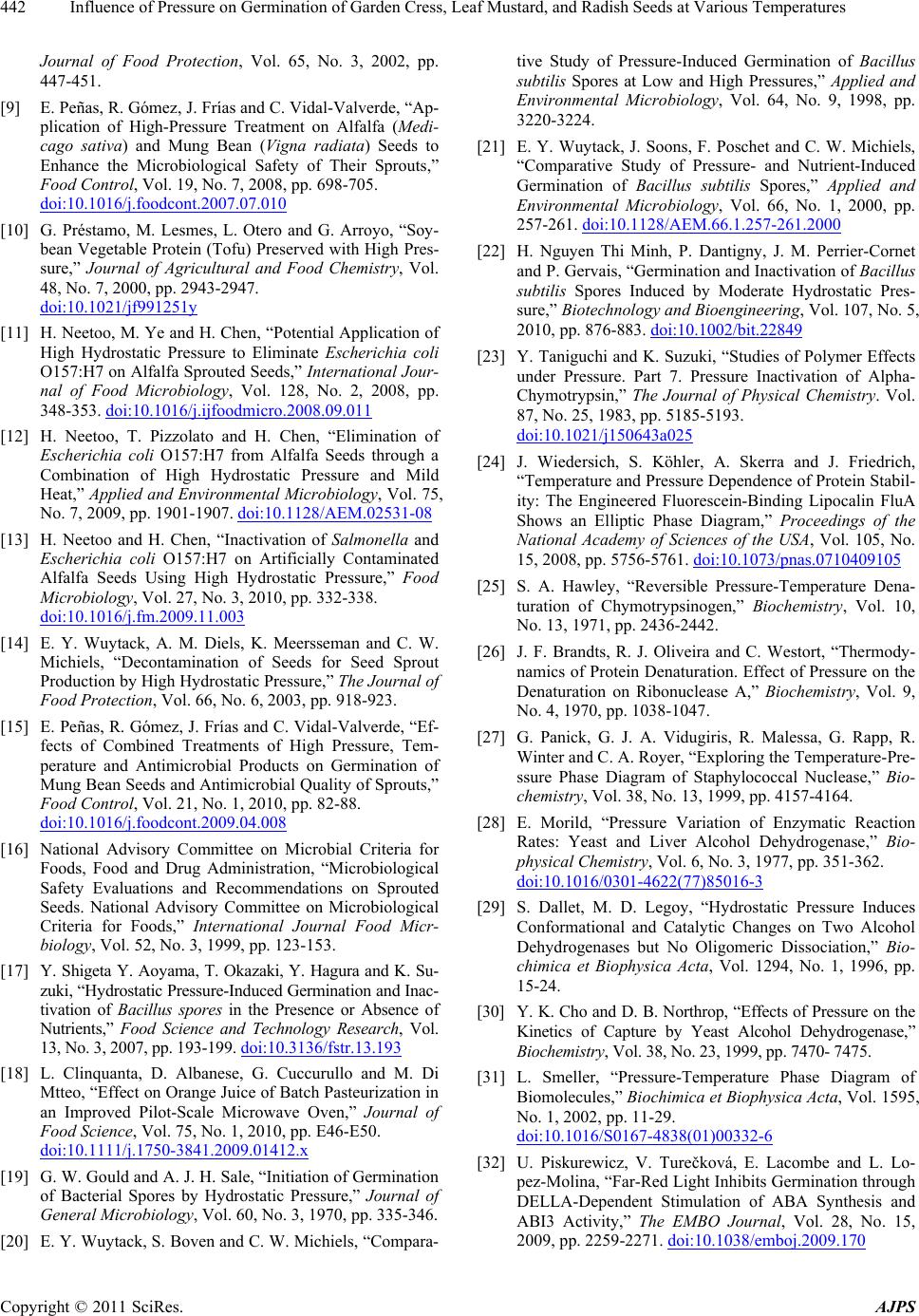
Influence of Pressure on Germination of Garden Cress, Leaf Mustard, and Radish Seeds at Various Temperatures
Copyright © 2011 SciRes. AJPS
442
Journal of Food Protection, Vol. 65, No. 3, 2002, pp.
447-451.
[9] E. Peñas, R. Gómez, J. Frías and C. Vidal-Valverde, “Ap-
plication of High-Pressure Treatment on Alfalfa (Medi-
cago sativa) and Mung Bean (Vigna radiata) Seeds to
Enhance the Microbiological Safety of Their Sprouts,”
Food Control, Vol. 19, No. 7, 2008, pp. 698-705.
doi:10.1016/j.foodcont.2007.07.010
[10] G. Préstamo, M. Lesmes, L. Otero and G. Arroyo, “Soy-
bean Vegetable Protein (Tofu) Preserved with High Pres-
sure,” Journal of Agricultural and Food Chemistry, Vol.
48, No. 7, 2000, pp. 2943-2947.
doi:10.1021/jf991251y
[11] H. Neetoo, M. Ye and H. Chen, “Potential Application of
High Hydrostatic Pressure to Eliminate Escherichia coli
O157:H7 on Alfalfa Sprouted Seeds,” International Jour-
nal of Food Microbiology, Vol. 128, No. 2, 2008, pp.
348-353. doi:10.1016/j.ijfoodmicro.2008.09.011
[12] H. Neetoo, T. Pizzolato and H. Chen, “Elimination of
Escherichia coli O157:H7 from Alfalfa Seeds through a
Combination of High Hydrostatic Pressure and Mild
Heat,” Applied and Environmental Microbiology, Vol. 75,
No. 7, 2009, pp. 1901-1907. doi:10.1128/AEM.02531-08
[13] H. Neetoo and H. Chen, “Inactivation of Salmonella and
Escherichia coli O157:H7 on Artificially Contaminated
Alfalfa Seeds Using High Hydrostatic Pressure,” Food
Microbiology, Vol. 27, No. 3, 2010, pp. 332-338.
doi:10.1016/j.fm.2009.11.003
[14] E. Y. Wuytack, A. M. Diels, K. Meersseman and C. W.
Michiels, “Decontamination of Seeds for Seed Sprout
Production by High Hydrostatic Pressure,” The Journal of
Food Protection, Vol. 66, No. 6, 2003, pp. 918-923.
[15] E. Peñas, R. Gómez, J. Frías and C. Vidal-Valverde, “Ef-
fects of Combined Treatments of High Pressure, Tem-
perature and Antimicrobial Products on Germination of
Mung Bean Seeds and Antimicrobial Quality of Sprouts,”
Food Control, Vol. 21, No. 1, 2010, pp. 82-88.
doi:10.1016/j.foodcont.2009.04.008
[16] National Advisory Committee on Microbial Criteria for
Foods, Food and Drug Administration, “Microbiological
Safety Evaluations and Recommendations on Sprouted
Seeds. National Advisory Committee on Microbiological
Criteria for Foods,” International Journal Food Micr-
biology, Vol. 52, No. 3, 1999, pp. 123-153.
[17] Y. Shigeta Y. Aoyama, T. Okazaki, Y. Hagura and K. Su-
zuki, “Hydrostatic Pressure-Induced Germination and Inac-
tivation of Bacillus spores in the Presence or Absence of
Nutrients,” Food Science and Technology Research, Vol.
13, No. 3, 2007, pp. 193-199. doi:10.3136/fstr.13.193
[18] L. Clinquanta, D. Albanese, G. Cuccurullo and M. Di
Mtteo, “Effect on Orange Juice of Batch Pasteurization in
an Improved Pilot-Scale Microwave Oven,” Journal of
Food Science, Vol. 75, No. 1, 2010, pp. E46-E50.
doi:10.1111/j.1750-3841.2009.01412.x
[19] G. W. Gould and A. J. H. Sale, “Initiation of Germination
of Bacterial Spores by Hydrostatic Pressure,” Journal of
General Microbiology, Vol. 60, No. 3, 1970, pp. 335-346.
[20] E. Y. Wuytack, S. Boven and C. W. Michiels, “Compara-
tive Study of Pressure-Induced Germination of Bacillus
subtilis Spores at Low and High Pressures,” Applied and
Environmental Microbiology, Vol. 64, No. 9, 1998, pp.
3220-3224.
[21] E. Y. Wuytack, J. Soons, F. Poschet and C. W. Michiels,
“Comparative Study of Pressure- and Nutrient-Induced
Germination of Bacillus subtilis Spores,” Applied and
Environmental Microbiology, Vol. 66, No. 1, 2000, pp.
257-261. doi:10.1128/AEM.66.1.257-261.2000
[22] H. Nguyen Thi Minh, P. Dantigny, J. M. Perrier-Cornet
and P. Gervais, “Germination and Inactivation of Bacillus
subtilis Spores Induced by Moderate Hydrostatic Pres-
sure,” Biotechnology and Bioengineering, Vol. 107, No. 5,
2010, pp. 876-883. doi:10.1002/bit.22849
[23] Y. Taniguchi and K. Suzuki, “Studies of Polymer Effects
under Pressure. Part 7. Pressure Inactivation of Alpha-
Chymotrypsin,” The Journal of Physical Chemistry. Vol.
87, No. 25, 1983, pp. 5185-5193.
doi:10.1021/j150643a025
[24] J. Wiedersich, S. Köhler, A. Skerra and J. Friedrich,
“Temperature and Pressure Dependence of Protein Stabil-
ity: The Engineered Fluorescein-Binding Lipocalin FluA
Shows an Elliptic Phase Diagram,” Proceedings of the
National Academy of Sciences of the USA, Vol. 105, No.
15, 2008, pp. 5756-5761. doi:10.1073/pnas.0710409105
[25] S. A. Hawley, “Reversible Pressure-Temperature Dena-
turation of Chymotrypsinogen,” Biochemistry, Vol. 10,
No. 13, 1971, pp. 2436-2442.
[26] J. F. Brandts, R. J. Oliveira and C. Westort, “Thermody-
namics of Protein Denaturation. Effect of Pressure on the
Denaturation on Ribonuclease A,” Biochemistry, Vol. 9,
No. 4, 1970, pp. 1038-1047.
[27] G. Panick, G. J. A. Vidugiris, R. Malessa, G. Rapp, R.
Winter and C. A. Royer, “Exploring the Temperature-Pre-
ssure Phase Diagram of Staphylococcal Nuclease,” Bio-
chemistry, Vol. 38, No. 13, 1999, pp. 4157-4164.
[28] E. Morild, “Pressure Variation of Enzymatic Reaction
Rates: Yeast and Liver Alcohol Dehydrogenase,” Bio-
physical Chemistry, Vol. 6, No. 3, 1977, pp. 351-362.
doi:10.1016/0301-4622(77)85016-3
[29] S. Dallet, M. D. Legoy, “Hydrostatic Pressure Induces
Conformational and Catalytic Changes on Two Alcohol
Dehydrogenases but No Oligomeric Dissociation,” Bio-
chimica et Biophysica Acta, Vol. 1294, No. 1, 1996, pp.
15-24.
[30] Y. K. Cho and D. B. Northrop, “Effects of Pressure on the
Kinetics of Capture by Yeast Alcohol Dehydrogenase,”
Biochemistry, Vol. 38, No. 23, 1999, pp. 7470- 7475.
[31] L. Smeller, “Pressure-Temperature Phase Diagram of
Biomolecules,” Biochimica et Biophysica Acta, Vol. 1595,
No. 1, 2002, pp. 11-29.
doi:10.1016/S0167-4838(01)00332-6
[32] U. Piskurewicz, V. Turečková, E. Lacombe and L. Lo-
pez-Molina, “Far-Red Light Inhibits Germination through
DELLA-Dependent Stimulation of ABA Synthesis and
ABI3 Activity,” The EMBO Journal, Vol. 28, No. 15,
2009, pp. 2259-2271. doi:10.1038/emboj.2009.170